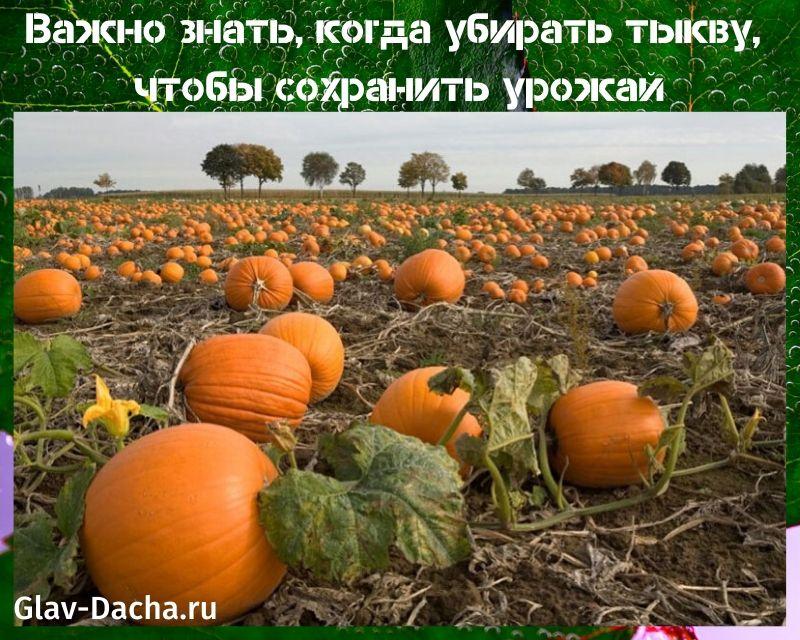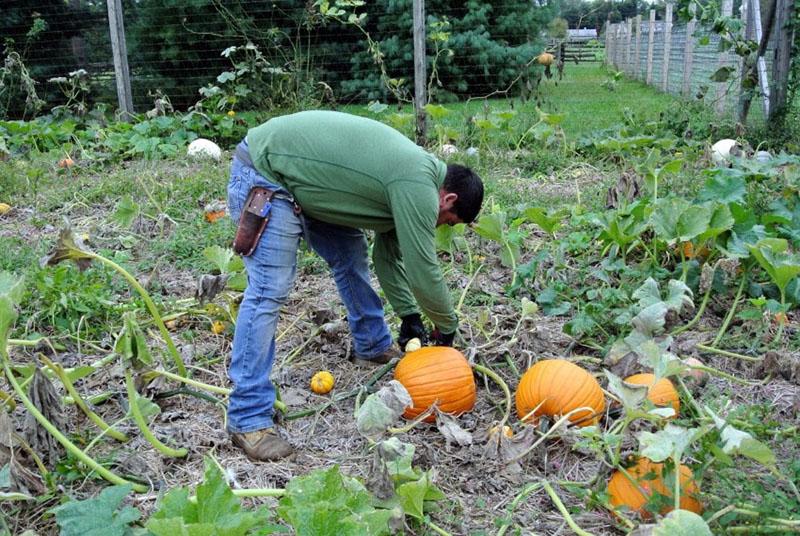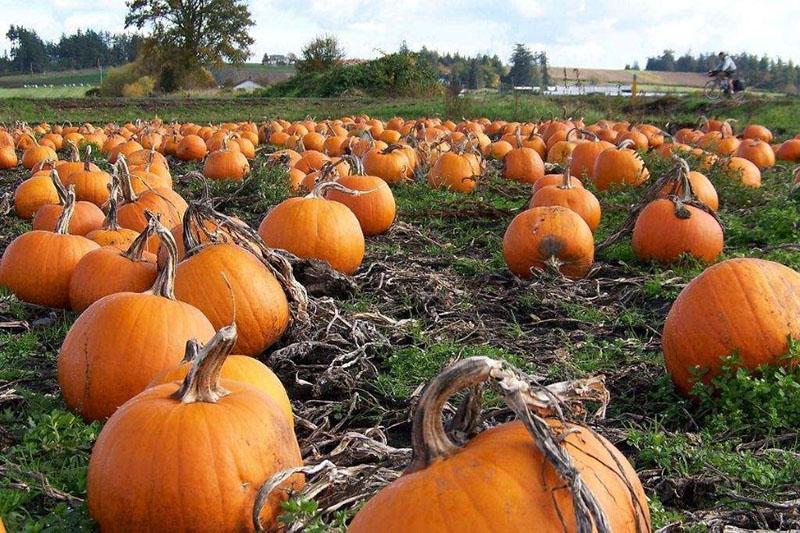It's important to know when to harvest pumpkin to preserve your harvest
 If the potato beds are vacated in the summer, then the pumpkin turns yellow with bright spots in the garden until autumn. But so that it does not last until the very frost, it is important to know when to harvest the pumpkin. Harvesting healthy and tasty fruits must be in a hurry and delayed. Let's hurry, and the pumpkin won't have time to accumulate sugar and fully ripen. Strawberry fruits run the risk of freezing from early frosts. And this will significantly reduce the storage time of the crop and its quality.
If the potato beds are vacated in the summer, then the pumpkin turns yellow with bright spots in the garden until autumn. But so that it does not last until the very frost, it is important to know when to harvest the pumpkin. Harvesting healthy and tasty fruits must be in a hurry and delayed. Let's hurry, and the pumpkin won't have time to accumulate sugar and fully ripen. Strawberry fruits run the risk of freezing from early frosts. And this will significantly reduce the storage time of the crop and its quality.
There is no single date when you can start cleaning. First, it depends on the variety, because there are pumpkins with short, medium and late ripening periods. Secondly, the growing climate also plays an important role. Pumpkin is a sun-loving vegetable and the more sun it receives and the warmer the summer, the earlier the harvest will ripen. Accordingly, in the south, in the center and in the northern regions, the harvesting time will differ significantly. How not to be late, prevent freezing, but at the same time remove the pumpkin on time and ripe? It is not difficult if you know the varietal characteristics of the vegetable and observe the weather conditions.
When to harvest pumpkin: harvest time depending on the crop variety

So, in terms of ripening, pumpkin happens:
- Early ripening, it is early. The growing season is 3.5 months. You can shoot at the end of summer, starting from the second decade of August. But early pumpkin is grown only for human consumption and also for the sake of seeds. Such vegetables cannot be stored for a long time, maximum - one month. However, for the northern regions, early varieties are just a find. They almost always have time to ripen before frost. And if they freeze, the short shelf life will not leave them a chance to deteriorate. Early ripe pumpkins include Almond, Golosemyannaya, Mozoleevskaya, Biryuchekutskaya, and Freckles.
- Mid-season. The fruits ripen a little longer, up to 4.5 months, and they need to be removed in the first decade of September. From mid-season varieties, pumpkins are grown Healing, Crumb, Smile, Volga gray.
- Late ripe. On average, late varieties ripen for 200 days. Their characteristic feature is their thick rind. It protects the pulp from spoilage and allows the fruit to be stored for a very long time, up to 6 months. They start harvesting the pumpkin later than everyone else, towards the end of September. Such late varieties are especially popular: Vitamin, Muscat, Pearl.
If the early varieties are grown in the north, then the later ones are grown only in the warm southern climate. In the open field in cold summer conditions, they do not have time to ripen.
Although some gardeners plant a pumpkin in greenhouse beds and get a harvest. You can act differently, removing the fruits in the semi-ripeness stage, and in a month they will "reach". But they won't be able to store for a long time.
How to tell if a pumpkin is ripe
 Regardless of the cultivar, there are several common signs that it is time to harvest.
Regardless of the cultivar, there are several common signs that it is time to harvest.
These are visual changes in the appearance of plants:
- the whips and leaves turn yellow and then dry up, because they give all their juices to the fruit;
- the peduncle also dries up and becomes very hard;
- the peel hardens;
- in almost all varieties, the skin acquires a pleasant yellow or orange color.
Pumpkin with gray and white color does not change skin color. In bush varieties, lighter stripes appear on the peel. Large-fruited species are covered with a dark mesh of veins, and nutmeg ones turn brown. In green-variety pumpkins, the pattern does not appear.
When to harvest pumpkin in different regions
 When buying seeds from the store, each package contains both the sowing date and the harvest date. But how accurate it will be depends on the climate. Usually the coincidence occurs only in the southern regions with warm and sunny summers. The further north the growing region is, the earlier the day comes when the pumpkin is removed from the garden. Conversely, in the south, the collection is postponed until mid-autumn. So, in the Krasnodar Territory, a pumpkin may well ripen under the sun until the first decade of October.
When buying seeds from the store, each package contains both the sowing date and the harvest date. But how accurate it will be depends on the climate. Usually the coincidence occurs only in the southern regions with warm and sunny summers. The further north the growing region is, the earlier the day comes when the pumpkin is removed from the garden. Conversely, in the south, the collection is postponed until mid-autumn. So, in the Krasnodar Territory, a pumpkin may well ripen under the sun until the first decade of October.
When to remove a pumpkin from a garden in the Leningrad region
 Winter in the Leningrad region is not very cold. But this region is characterized by unstable temperatures during the rest of the year. Spring is long here, while summer is not hot and "bored" with frequent and abundant rainfall. For a pumpkin that does not like excess moisture and requires a lot of sun, such conditions are not the most comfortable. In addition, the weather is often "happy" with both late spring, May, and early September frosts.
Winter in the Leningrad region is not very cold. But this region is characterized by unstable temperatures during the rest of the year. Spring is long here, while summer is not hot and "bored" with frequent and abundant rainfall. For a pumpkin that does not like excess moisture and requires a lot of sun, such conditions are not the most comfortable. In addition, the weather is often "happy" with both late spring, May, and early September frosts.
At what time to remove the pumpkin from the garden depends on its variety. In the Leningrad region, early pumpkin is mainly grown, which is removed from the garden in August. It is small and used only for food consumption. Stored for no more than a month.
Planting late varieties is not recommended, for long-term storage it is better to try mid-season species.
They do not reach full maturation in the open field. But if you pick the fruits half-green in early September, they will reach during storage.
When to harvest pumpkin in the Urals
 The Ural spring comes late, but the main feature of this region is a sharp change in temperature. Even at the beginning of summer, night frosts are possible there, while temperatures remain above zero during the day. This pushes the planting dates, respectively, and the harvest is carried out later.
The Ural spring comes late, but the main feature of this region is a sharp change in temperature. Even at the beginning of summer, night frosts are possible there, while temperatures remain above zero during the day. This pushes the planting dates, respectively, and the harvest is carried out later.
Provided that the beginning of autumn is warm, the fruits can remain on the lashes until the first half of September. This applies to mid- and late-ripening varieties. Early views can be filmed in late summer.
The main thing is not to leave the vegetable in the beds until frost, because then it will not be stored. Better to let it ripen in the pantry.
When pumpkin is harvested from the garden in Siberia
 The most severe and difficult conditions for gardeners are Siberian. Cold winters, late spring, quickly turning into short and cool summers, leaves no choice. Only early varieties have a chance to ripen on lashes. But often they have to be removed 2 weeks before full ripeness, starting from the second half of August. The territory of Siberia is huge, and most of it is not particularly suitable for growing heat-loving crops in the open field.
The most severe and difficult conditions for gardeners are Siberian. Cold winters, late spring, quickly turning into short and cool summers, leaves no choice. Only early varieties have a chance to ripen on lashes. But often they have to be removed 2 weeks before full ripeness, starting from the second half of August. The territory of Siberia is huge, and most of it is not particularly suitable for growing heat-loving crops in the open field.
How to harvest pumpkin
 It is best if you wait until the moment and let the healthy fruits ripen in the beds under the sun. These vegetables are the tastiest and sweetest. When the lashes are dry, you can start cleaning. Separate them with a sharp knife or pruner. Although the stalk dries up, it is quite difficult to tear it off with your hands, because it holds firmly. In addition, there is a risk of damaging the pulp near the cutting, and then the fruits will quickly begin to deteriorate. For the same reason, do not carry the pumpkin by the stalk. They can come off at the most inopportune moment, and the fruit - fall to the ground. Any damage to the bark (cracks, scratches, bruises) will lead to the fact that the pumpkin can no longer be stored.
It is best if you wait until the moment and let the healthy fruits ripen in the beds under the sun. These vegetables are the tastiest and sweetest. When the lashes are dry, you can start cleaning. Separate them with a sharp knife or pruner. Although the stalk dries up, it is quite difficult to tear it off with your hands, because it holds firmly. In addition, there is a risk of damaging the pulp near the cutting, and then the fruits will quickly begin to deteriorate. For the same reason, do not carry the pumpkin by the stalk. They can come off at the most inopportune moment, and the fruit - fall to the ground. Any damage to the bark (cracks, scratches, bruises) will lead to the fact that the pumpkin can no longer be stored.
To the question of at what temperature to remove the pumpkin from the garden, there is only one answer - unambiguously with positive values.
Leaving the fruit in the beds before frost does not greatly change the taste. But it will shorten the shelf life, and the pulp will become cottony.Frozen pumpkin can and should be eaten, since it will not be stored for a long time.
After harvesting, do not forget to clean the fruits of soil and vegetation residues and dry them. It is better to do this outdoors, leaving the vegetables under a canopy. If necessary, if the pumpkin had to be harvested half-ripe, send it for ripening. But not outdoors, but in a warm place, transferred to a dry room.
Sort the pumpkins just before storing. Set aside damaged and small vegetables separately and use them first. For storage, select healthy and large fruits.
How to properly store a harvested pumpkin
 Rarely, when fruits are stored in apartment conditions, especially in large quantities. These are not onions or potatoes, and finding enough space for large pumpkins is problematic. In addition, it is difficult to maintain the optimal temperature in the house for long-term storage. The pumpkin stays at a maximum temperature of 13 ° C for the longest time, although it can be stored at 20 ° C for some time. However, in most cases, during the heating season, the house is much warmer.
Rarely, when fruits are stored in apartment conditions, especially in large quantities. These are not onions or potatoes, and finding enough space for large pumpkins is problematic. In addition, it is difficult to maintain the optimal temperature in the house for long-term storage. The pumpkin stays at a maximum temperature of 13 ° C for the longest time, although it can be stored at 20 ° C for some time. However, in most cases, during the heating season, the house is much warmer.
It is best to store crops in a pantry, basement or cellar. The premises should be unheated, well ventilated and dark. At the same time, the temperature in them in winter should not drop below 3 ° C. Do not heap the fruits on a pile; it is better to lay them in one layer on shelves or in boxes. It is advisable that the vegetables do not touch. If one goes bad, the rot cannot spread to the rest.
It is not recommended to put next to the pumpkin apples, quince, pears. They release ethylene, which will accelerate the ripening of the fruit, which means that they will begin to deteriorate faster.
Thus, the timing of when you can collect pumpkin from the garden is determined by its variety and growing climate. The shorter the growing season of the plant and the warmer the summer, the earlier it will ripen. The use of early species allows planting and harvesting even in the vast expanses of Siberia.